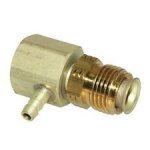mr300z87
Senior Chief Petty Officer
- Joined
- Sep 15, 2010
- Messages
- 694
Hi all, I have posted before regarding my friends 5.7L in an 89 Sea Ray Sundancer 250 that ingested water on it second voyage after a rebuild. Anyway last fall he pickup a running drop in 260 HP 5.7L Rochester 4 barrel thunderbolt IV engine of 89-95 vintage. Before he bought it they did a comp check while he was with them and all 8 were between 140 and 150. I personally heard the engine run on the ground when we pick it up. We installed the engine last fall an put it away for the winter. Back in July we made all the final assembly and launched the boat. The boat ran OK from the ramp to his house. It has been in the water since then with little use because it develops miss after cruising for a while. Are thoughts are it was an issue with the carb.
This gets me to today, even though it was cold and raining today we went to his house to help him with some wiring and swap carbs to the one from his old engine. Back when we launched the boat we set timing, other than that I do not know much about the state tune of the engine( plugs Cap rotor??). So we swamped the carb to another Rochester 4 barrel. She fired up and idled nice and smooth, so we decided to venture out in the rain to see how she ran. We idled out of his canal through the no wake area with no troubles. Once clear of no wake we throttled up onto plane and were cruising around 3500 RPM at 22 MPH after a few min we noticed a slight drop in RPM, them it would pick back up. He then pushed the throttle to just above 4000 RPM and she sounded like it was pinging (detonation) so I had him back off to around 3500 RPMs where it ran good again for another few min. Then like before the RPMs would drop then come back up but this time is started popping from the carb, but now more throttle caused it to bogged. We also had a bad exhaust odor in the cockpit (full camper top up). Back at no wake speed she ran fine. BTW it seem better with this carb than the one that came on the engine. Back in July when we were out and the missed developed we opened the fuel fill to make sure the vent was not clogged. The screw on fuel filter is new and the one we checked the one in the carb before installing it. He is buying a rebuild kit for the Carb so I will go through it when it comes in. What else could cause this? Ignition? Of course we sold his old one. Sorry for the long winded post but I am trying to provide the most info I can to help trouble shoot this problem. All this because he changed the name without the proper ceremony, LOL. As always any advise is appreciated. Have a great night.
This gets me to today, even though it was cold and raining today we went to his house to help him with some wiring and swap carbs to the one from his old engine. Back when we launched the boat we set timing, other than that I do not know much about the state tune of the engine( plugs Cap rotor??). So we swamped the carb to another Rochester 4 barrel. She fired up and idled nice and smooth, so we decided to venture out in the rain to see how she ran. We idled out of his canal through the no wake area with no troubles. Once clear of no wake we throttled up onto plane and were cruising around 3500 RPM at 22 MPH after a few min we noticed a slight drop in RPM, them it would pick back up. He then pushed the throttle to just above 4000 RPM and she sounded like it was pinging (detonation) so I had him back off to around 3500 RPMs where it ran good again for another few min. Then like before the RPMs would drop then come back up but this time is started popping from the carb, but now more throttle caused it to bogged. We also had a bad exhaust odor in the cockpit (full camper top up). Back at no wake speed she ran fine. BTW it seem better with this carb than the one that came on the engine. Back in July when we were out and the missed developed we opened the fuel fill to make sure the vent was not clogged. The screw on fuel filter is new and the one we checked the one in the carb before installing it. He is buying a rebuild kit for the Carb so I will go through it when it comes in. What else could cause this? Ignition? Of course we sold his old one. Sorry for the long winded post but I am trying to provide the most info I can to help trouble shoot this problem. All this because he changed the name without the proper ceremony, LOL. As always any advise is appreciated. Have a great night.





















